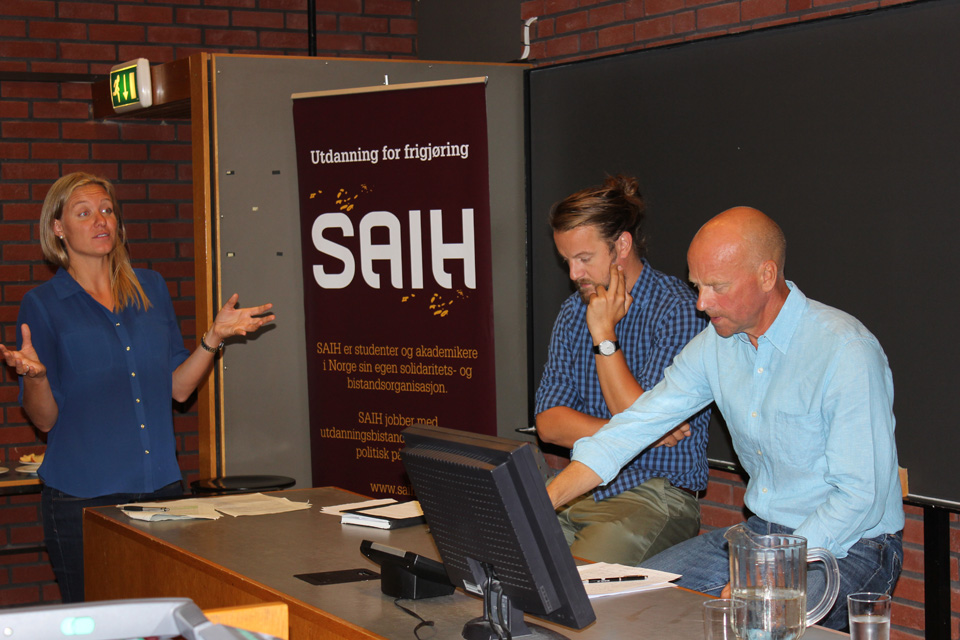Paul Garside and Jonas Holmqvist
On Tuesday 12th of August, FIVAS, in collaboration with Saih and The Center for Development and Environment (SUM), arranged a development seminar at UiO on the Millennium Development Goals. On the panel was Malcolm Langford, Research Fellow at the Norwegian Centre for Human Rights and Director of the Socio-Economic Rights Programme, Hans Olav Ibrekk, Policy Director with the International Energy and Climate Initiative at the Ministry of Foreign Affairs and Jonas Holmqvist, director for FIVAS. Chairing the event was Kristina Fröberg, senior advisor in ForUM.
Measurements vital
Jonas Holmqvist from FIVAS opened the seminar by highlighting some of the processes that have led up to the post 2015 goals. It is a process that has been going on for some time, forward to next summer in 2015, when the finalizing conference is planned. The UN conference Rio+20 in 2012 set out a mandate to establish an Open Working Group to develop a set of sustainable development goals (SDGs) and provide the basis for their conceptualization and negotiation. The millennium development goals (MDGs) has their deadline in 2015, and as such new UN development goals are in line. The Rio+20 outcome gave the mandate that the SDGs should be integrated into the general UN agenda on the post 2015 development goals.
Water was important in the MDGs and will be even more important in the Post-2015 development agenda. Reportedly, the MDG goal for access to water was reached before time; however, the goal on sanitation is far from reaching its ambition. The way in how to measure the water goal is also contested. With huge loopholes, can we really say to have reached our aim? All this should be taken into consideration when the new development agenda is shaped and targets are formulated.
There has been a shift in the discussion on water, from the 90s and 2000s when it centered on the right to water, to recently where the dominant paradigm is that of water scarcity. Jonas outlined that FIVAS prefers a focus on how to share the water that is available equitably. There are problems with for example overuse, pollution and economic scarcity that need to be dealt with first and should take priority. Although the goal of halving the number of people that did not have access to improved sources of water was achieved (according to UN statistics), the goal of access to improved sanitary conditions is not going to be reached at all. There is an interesting dynamic in the sense that where we aimed to come the furthest, the least has been achieved. He also mentioned studies that showed how communities had been categorized as having improved access to water, when in actual fact, the new water infrastructure projects that had been given credit, were not necessarily providing improved availability or quality.
The chair for the seminar Kristina Fröberg, senior advisor at the Norwegian Forum for environment and development, ForUM, outlined how the new development goals will likely shape Norway’s development policy going forward and that is was important civil society has a say in how this happens. She stressed that the very broad consultation in the formation of the goals is a new approach, and one that gives the civil society greater leverage than in previous processes.
Muddying the Water
Malcolm Langford, has researched rights and development for a considerable time, both at UiO’s Center for human rights, and currently at CMI. He recently co-authored an article titled Muddying the Water? Assessing Target-based Approaches in Development Cooperation for Water and Sanitation, which provides an analysis of past and present target setting in development cooperation from the perspective of the water sector.
Malcolm began by describing the way in which the MDGs promote different concepts depending on what angle they are perceived from. For example they can be viewed from a human rights perspective with a focus on human wellbeing. Or they can be viewed from an economic and social rights perspective with the idea of progressive realization where states have the time to gradually realize these rights, within a reasonable period of time.
Malcolm outlined several critiques of the MDGs. From a human rights approach, the MDGs are incoherent in terms of the design and ineffective in their own realization. Social security, equality, disability are excluded from the goals which they should not have been. The different goals had different ambitions resulting in them creating confusion. There were weak forms of accountability and issues of legitimacy. Some goals may could have potentially promoted human rights violations for instance in the case of the slum grading targets and the impact on communities that were evicted as a result.
From a positive perspective, the MDGs changed our discourse, and got the world to focus more on poverty reduction and improved levels of planning and budgeting for areas covered by the MDGs. Never previously has there been such an sustained rallying around development targets. The process has lead to a part realization of some of the targets. Health and education for example received a big boost. The budget for water was increased. But Malcolm stressed that the big question was how progress is measured. According to the statistics, there has been increased access to water and reduced levels of poverty. Little progress was made in sanitation and maternal mortality for example. So results have been mixed.
Post 2015
Malcolm Langford pointed out that the SDGs were not just average targets but contained important elements addressing equity. Closer attention will be made on who is benefitting, as opposed to solely looking at what is achieved. The Rio declaration set the frame for the post 2015 agenda.
Malcom outlined how the goals needed to be:
“action oriented, concise, easy to communicate, limited in number, global in nature, universally applicable to all countries while taking into account different national realities, capacities and levels of development, and respecting national policies and priorities”.
Water affordability was not included in the MDGs, even though it has been identified as a major factor affecting access to water in the world. Malcolm was clear in his explanation of the fact that basic access to water is a function of the general water availability in only a few countries in the world, making this issue an exception rather than the rule. Rather, he pointed to political will as being the limiting factor.
In the MDSs the water goal was buried in target number 7 on environment, but in the SDGs it has its own goal which is an important step. The goal aims to achieve universal and equitable access to safe and affordable drinking water for all by 2030. The goal takes into account a number of critiques including the affordability issue, universality and equitability. By addressing equitability, it is presumed all income groups are addressed simultaneously.
Could the water challenge solve itself?
Hans Olav Ibrekk from the Ministry of foreign affairs have had a sidewinding career, from water to energy and climate, a development that to some extent are mirroring the Norwegian priorities. Norway’s focus on water is now relatively small.
Ibrekk started by looking forward saying that f we look forward to 2050 there will be maybe 9 billion people, climate change really begins to take effect, and water consumption will increase, we will also need to produce more food. He also discussed the possibility for more conflict: Increased scarcity, use, consumption, competition, leads to conflicts. Some try to attribute various conflicts to water and the environment but it is difficult to draw definite conclusions. Water is more often a source of collaboration than a source of conflict. If there is scarcity – we see people working together.
Ibrekk pointed out that many who don’t have water also lack access to energy and other things. Malcolm Langford showed a very interesting correlation between economic development and access to water and sanitation. The correlation between GDP and access to modern energy is not as clear. The correlation between GDP per capita and access to water and sanitation services means that we can actually sit back and let most of this be solved with economic development. In principal when you reach a particular economic level most countries will be able to offer a basic service level. But we have to take into account that inequalities become bigger. As well as the MDGs we have also had the IDGs – international development goals – in the 1990s. The MDGs have gotten far more attention than the IDGs ever got – that we continue to talk about the MDGs is amazing, in this branch, where we talk about new things every month. The beauty of the MDGs are at they are communicable, easy to handle.
Today one third of the world’s population do not have access to sanitation. Hans Olav spoke about the problem of access to sanitation as a “soft problem”, not primarily connected to hardware. Dignity is a key word for sanitation. The problem of the rape of girls and young women in India is one aspect of this problem, keeping girls enrolled in school as they enter puberty is another. If girls do not have good sanitation at the schools, they will drop out. Ministers speak on water and sanitation, and on girls attending school, but it is a problem to address these issues directly. Both politicians and other officials have difficulties talking about these issues.
Ibrekk said that we need all the resources we can get to realize water and sanitation needs.
– We need public money, the users must pay, and we have to get in private actors, we cannot say no to that financing option.
Who decides the indicators?
After the individual presentations there was a panel discussion that centered around the issue of measuring achievement. It was pointed out that numbers, or quantification, is crucial for communication of the targets. It is also an inherent problem how to dimension the indicators that will be used within each target. A study from Senegal done just after the launching of the MDGs shows that the way we measure access is decisive. When measuring for affordability it found that the numbers that did not have access doubled, when it measured for quality of water it doubled again. And what about consistency of supply? Some studies show that half the world lack access to water if we apply such definitions, as opposed to the 800 million which is the predominant number used. What could we do to reach 4 billion people?
Still it is quite possible the indicators cannot be agreed upon by political leaders in the negotiations and must be left out of Post-2015 goals which are to be agreed upon. In that situation it would be up to the UN bureaucrats to design the indicators.
The panelists also visited whether the current suggested goal for water is a good goal. Equity is seen as an important threshold, that this is included is promising. The goal on universal access was deemed as a very clearly crafted goal. The panel also revisited the stigma around sanitation. The goal to achieve access for adequate and equitable sanitation for all also entails the aim to end open defecation. If this can be reached it has a huge impact for water quality and health.
It was reiterated that the access to sanitation is a “soft issue” i.e. an issue about norms and culture. But also an issue of politics. Of the 100 million toilets supplied in India as part of the MDG effort after 1996 none of them reached the poorest 40 %.


